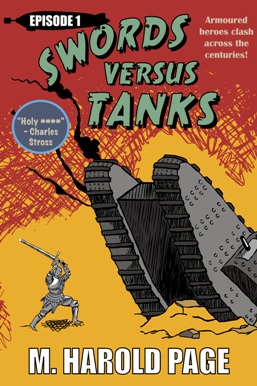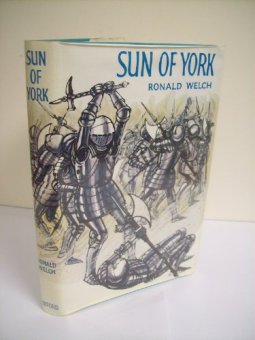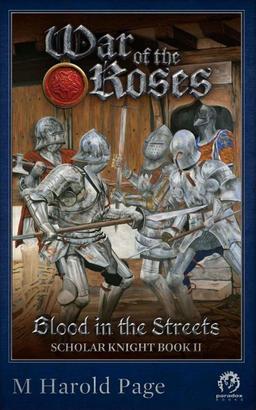Armored Rampage!

Somebody yells, “Form a wedge! Form a wedge!”
This is my last chance to experience something I’ve craved since reading Ronald Welch’s Sun of York back when I was twelve. I love my plate armor, but I’m now in my forties, a dad, and my days of hitting the road with my armor are numbered. (“Write what you know”, they said. So I had set out to know what I wanted to write about.)
“Let me go first!”
I take my place at the front of the knot of my friends in armor from different periods. Everybody jostles around and, without the benefit of NCOs, forms a rough triangle with me at the point.
Ahead, the Viking ranks stiffen, dress their shields. Locals mostly, and many of them students, so there’s a lot of quilted armor and even some linen shirts.
I grin into my visor. We’re older, heavier in build. One-to-one we outweigh them and we’ve concentrated our weight into a human battering ram…
…and yes, it’s a small multi-period medieval faire at St Andrews, Scotland. The weapons aren’t sharp. It’s not real.
But read on, because the experience was illuminating…
You see, as an experiment, we all have Hit Points. It was something like…
- Under-equipped Vikings in shirts (please don’t hit them too hard), 1 HP.
- Padded armour, 2 HP
- Mail shirts, 3 HP
- Half armour, 4 HP
- Me in my Milanese plate, 7 HP.

Oh, and did I mention Agnes Dei, my 52-inch bladed two handed sword?
I don’t remember who shouted “charge!” but I do remember clattering across the grass with a tonne of metal close behind me and thinking, “Oh, ####. This is ####ing dangerous.”
Then we slammed into the shieldwall.
Through the shield wall.
Afterward, in the chaos of broken ranks and outflanked Vikings, I simply used Agnes like a spear, taking out anybody within three yards or more of me. Had it all been real, I would have had to endow a chantry and go on pilgrimage before the nightmares stopped bothering me.
However, it’s the moment of impact that was interesting.
It was too fleeting for any kind of fencing. I wasn’t even trying to hit anybody — I had one hand on the blade, “halfsword”, so as to shove through the shields. I definitely took some hits including one — an accident, I’m sure — to the back of the head. However, the kit I was wearing would have kept me alive in a real battle, so I didn’t care.
Didn’t care? I felt like a god!
But, what if the weapons had been sharp and somebody had been trying to kill us? A hedgehog of pikes or polearms would have brought us to a standstill and, out reached, we would have been cut to pieces. Literally.
However, against anything less than ranks of well ordered polearms, we would have been unstoppable, at least for a while.
To take out a knight, you have to go through or around his (or perhaps, her, because though the record does not attest to any authentic Ash’s, it would not be so hard to hide your gender behind padding and plate, and there have always been the odd woman passing as a man to pursue a soldierly vocation).

A well placed spear might pierce mail, but in a mail-on-mail charge, the attacker is behind his shield (and we already specified no hedgehogs), and in a plate-armored charge, the mailed gaps are hidden by dangling bits of steel.
So, regardless of the date, through the armor during a charge requires a good, square, blow, not a thrust.
Each period has its knightly panzerfaust — mace and daneaxe versus mail, poleaxe and variations against plate — but even these don’t do much if you just score a glancing strike. (Look at the punishment people can take in the Battle of the Nations.)
However, if somebody is rushing up to you across uneven ground, it’s very hard to get the timing right, even harder if one or both of you are on horseback — presumably why Napoleonic era cavalry tended to present the point when charging. Even if you do score a killing strike, you’re spent and the rest of the charge is on you, and the sheer mass bowls you over.
Meanwhile, in a charge there is no around the armor.
Well, OK, helmets have eye slits or open faces, they are easy to cover when rushing forward. You can hook a weapon up the armoured skirt, or inside the cuffs, but that’s not practical except in the melee. Yes, plate has gaps, but these are filled by mail gussets sewn to the arming jacket. You can try for them, but see above.
So, as a knight:
- You are immune to glancing blows that would concuss or rip open a less well armoured comrade, even when facing weapons designed to kill you.
- If you can keep going, then most of the blows will be glancing.
Hence the armored rampage.

This explains the ability of real knights to make like a Frazetta, and have a disproportionate impact on the outcome of a battle.
Take the First Crusade: At the Siege of Jerusalem, Godfrey de Bouillon leaps off a jammed siege tower onto burning wooden hoardings, then single-handedly clears the battlements. Later, at the Battle of Ascalon (according to Harold Lamb), when the crusaders are enveloped by a much larger army, Robert of Normandy saves the day by the simple expedient of personally carving his way to the enemy standard and cutting down the standard bearer.
This also explains how knightly disasters could be magnificent rather than anticlimactic.
Take the unwise charge of the French chivalry at Nicopolis (1396). The knights weather mounted archers, brave sharpened stakes, then slam into the Ottoman foot, who they slaughter in droves. Now disorganised, the knights face a charge by Ottoman heavy cavalry, who they route. Finally, Bayezid’s elite troops roll their flank, and the French knights die hard, taking an inordinate number of enemies with them. They were skilled and brave, but without the armour, all those little injuries would have added up.
On smaller scale, we have that charge out of the pub at the first Battle of St Albans (1455).
The remaining Lancastrian leaders simply burst out of the Castle Inn and charge the entire Yorkist Army.
What’s remarkable is not the suicide charge — military history is full of them — but that the attack lasted long enough for the Duke of Buckingham to come to blows with the Earl of Warwick!
So, I was very happy to open my novel Swords Versus Tanks 1: Armored heroes clash across the centuries! with the protagonist, Sir Ranulph Dacre, buying time for his men by counter charging an entire army:
Albrecht yelled something.
But Ranulph was striding forward, Steelcutter raised to greet the oncoming army, his gaze fixed on the Red Unicorn banner fluttering over the throng. If he was going to die today, Clifford would precede him down to Hell.
Because that’s the kind of thing knights did.
M Harold Page has several franchise novels in print. You can download Swords Versus Tanks 1: Armoured heroes clash across the centuries! from Amazon. He is currently editing Swords Versus Tanks 2: Vikings battle Zeppelins! Clashing cultures spark forbidden desires! which is due out in the next couple of weeks.
You go to all the best parties.
I remember many years back my cousin and I participated in these “tournaments” and they were lots of fun. I remember when we first started, dueling with padded sticks in his garage, I was the first one to bleed. Got a cut underneath my eye. That prompted us to get armor and things just escalated from there.
Thanks for the article. I thoroughly enjoyed it.